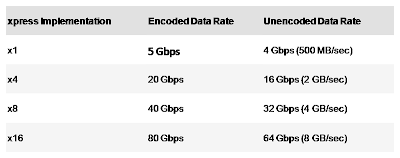The bandwidth of a PCI Express link can be scaled by adding signal pairs to form multiple lanes between the two devices. The specification supports x1, x4, x8, and x16 lane widths and stripes the byte data across the links accordingly. Once the two agents at each end of the PCI Express link negotiate lane widths and frequency of operation, the striped data bytes are transmitted with 8b/10b encoding.
The basic "x1" link has a peak raw bandwidth of 2.5 Gbps. Because the bus is bidirectional (that is, data can be transferred in both directions simultaneously), the effective raw data transfer rate is 5 Gbps. Table below summarizes the encoded and unencoded data rates of x1, x4, x8, and x16 implementations, which are defined in the initial generation of PCI Express.
Table: PCI Express Bandwidth
In contrast to PCI, PCI Express has minimal sideband signals and the clocks and addressing information are embedded in the data. Because PCI Express is a serial technology with few sideband signals, it provides a very high bandwidth per I/O connector pin compared to PCI. This is designed to result in more efficient, smaller, and cheaper connectors. Figure below compares the bandwidth per I/O connector pin of PCI, PCI-X, AGP, and PCI Express.Future implementations of PCI Express will raise the channel communication frequency to even higher levels. For example, a second generation of PCI Express could increase the communication frequency by a factor of 2 or more.
Because it is a point-to-point architecture, the entire bandwidth of each PCI Express bus is dedicated to the device at the end of the link. Multiple PCI Express devices can be active without interfering with each other.
Figure. Comparison of I/O Bus Bandwidth Per Pin
PCI Express technology achieves high data rates reliably by using low-voltage differential signaling. In this approach, the signal is sent from the source to the receiver over two lines. One contains a "positive" image and the other, a "negative" or "inverted" image of the signal. The lines are routed using strict routing rules so that any noise that affects one line also affects the other line. The receiver collects both signals, inverts the negative version back to the positive and sums the two collected signals, which effectively removes the noise.
The original PCI Express specification defines graphics cards with up to 75 watts of power. In addition, a new high-end PCI Express graphics specification is under development that defines cards of up to 150 watts. These higher power levels accommodate the requirements of graphics adapters, which currently peak at 41 watts for mainstream AGP cards and 110 watts for AGP Pro 110 cards.






No comments:
Post a Comment
Please provide valuable comments and suggestions for our motivation. Feel free to write down any query if you have regarding this post.